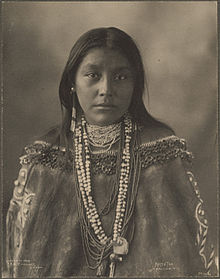
Hattie Tom, Chiricahua Apache.
Today Chiricahua are enrolled in two federally recognized tribes in the United States: the Fort Sill Apache Tribe, located near Apache, Oklahoma with a reservation in Los Lunas, New Mexico, and the Mescalero Apache Tribe of the Mescalero Reservation near Ruidoso, New Mexico the San Carlos Apache Tribe, Arizona does have Chiricahua Apache people there also.
The Chiricahua Apache were initially given their name by the Spanish. They are also known as the Chiricagui, Apaches de Chiricahui, Chiricahues, Chilicague, Chilecagez, and Chiricagua. The White Mountain Apache, including the Cibecue and Bylas groups of the Western Apache, called them Ha'i’ą́há and the San Carlos Apache called them Hák'ą́yé both meaning ″'Eastern Sunrise, i.e. People in the East". Navajo call the Chiricahua Chíshí.
Their autonym for themselves is depending on the dialect simply Nde, Ne, Néndé, Héndé or Hen-de - ″The People, Men″, they never called themselves ″Apaches″. Sometimes it is noted that all Apaches called the Americans and European settlers (with exception of the Mexicans) pindah-lickoyee ("White Eyes"), but this seems an appellation from Mescalero and Lipan Apache bands, the Chiricahua bands called the whites daadatlijende (″Blue/green eye people″) or indaaligande (″white skinned people″ or literally ″strange, not Apache people, which are white skinned″).
Several loosely affiliated bands of Apache came improperly to be usually known as the Chiricahuas. These included the Chokonen (recte: Tsokanende), the Chihenne (recte: Tchihende), the Nednai (Nednhi) and Bedonkohe (recte, both of them together: Ndendahe). Today, all are commonly referred to as Chiricahua, but they were not historically a single band nor the same Apache division, being more correctly identified, all together, as "Central Apaches".
Many other bands and groups of Apachean language-speakers ranged over eastern Arizona and the American Southwest. The bands that are grouped under the Chiricahua term today had much history together: they intermarried and lived alongside each other, and they also occasionally fought with each other. They formed short-term as well as longer alliances that have caused scholars to classify them as one people.
The Apachean groups and the Navajo peoples were part of the Athabaskan migration into the North American continent from Asia, across the Bering Strait from Siberia. As the people moved south and east into North America, groups splintered off and became differentiated by language and culture over time. Some anthropologists believe that the Apache and the Navajo were pushed south and west into what is now New Mexico and Arizona by pressure from other Great Plains Indians, such as the Comanche and Kiowa. Among the last of such splits were those that resulted in the formation of the different Apachean bands whom the later Europeans encountered: the southwestern Apache groups and the Navajo. Although both speaking forms of Southern Athabaskan, the Navajo and Apache have become culturally distinct.
The Tsokanende (Chiricahua) Apache division was once led, from the beginning of the 18th century, by chiefs such as Pisago Cabezon, Relles, Posito Moraga, Yrigollen, Tapilà, Teboca, Vivora, Miguel Narbona, Esquinaline, and finally Cochise (whose name was derived from the Apache word Cheis, meaning "having the quality of oak") and, after his death, his sons Tahzay and, later, Naiche, under the guardianship of Cochise's war chief and brother-in-law Nahilzay, and the independent chiefs Chihuahua, Ulzana, Skinya and Pionsenay; Tchihende (Mimbreño) people was led, during the same period, by chiefs as Juan Josè Compa, Fuerte a.k.a. Soldado Fiero, Mangas Coloradas, Cuchillo Negro, Delgadito, Ponce, Nana, Victorio, Loco, Mangus; Ndendahe Apache people, in the meanwhile, was led by Mahko and, after him, Mano Mocha, Coleto Amarillo, Luis, Laceres, Felipe, Natiza, and finally Juh and Goyaałé (known to the Americans as Geronimo). After Victorio's death, Nana, Geronimo, Mangus (youngest Mangas Coloradas' son) and youngest Cochise's son Naiche were the last leaders of the Central Apaches, and their mixed Apache group was the last to continue to resist U.S. government control of the American Southwest.
BEN
Kin 93: Red Lunar Skywalker
I polarize in order to explore
Stabilizing wakefulness
I seal the output of space
With the lunar tone of challenge
I am guided by the power of life force
I am a galactic activation portal
Enter me.
The mind, or the thinking layer of the mind, is above and beyond the raw storage of different perceptions, stimuli and experience.*
*Star Traveler's 13 Moon Almanac of Synchronicity, Galactic Research Institute, Law of Time Press, Ashland, Oregon, 2015-2016.
The Sacred Tzolk'in
Muladhara Chakra (Seli Plasma)




No comments:
Post a Comment